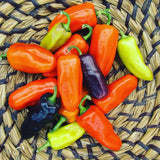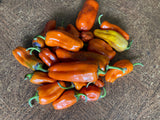Pippin's Golden Honey Pepper
Capsicum annuum
This colorful sweet pepper ripens from a deep dark purple to a bright honey-mustard, to a cheerful golden orange. The 3-4" fruits have thin walls, making it great for stuffing, pickling, or eating fresh. This is one of the many peppers traded by Philly Area folk artist Horace Pippin for bee stings from H Ralph Weaver's hives in West Chester in the early 1940s. In a deep freezer, nearly half a century ago, William Woys Weaver found these seeds (as well as those of the Fish Pepper and many others) in labeled baby food jars.
Days to maturity: 80
Seeds per pack: 25
Germination rate: 91% on 11/27/2024
Planting / harvesting notes
Start seeds indoors 8-10 weeks before the last frost and transplant into garden well after the danger of frost. Keep seedlings moist but do not overwater. Transplants should be initially watered in well, and plants will be most productive with regular irrigation and full sun.
Seed keeping notes
Peppers are generally self-pollinating, though we isolate different varieties of the same species by at least 50 feet, in hopes that flying insects will not cross pollinate them unexpectedly. There are several important species of peppers, so check your scientific names! Pepper seeds are ripe when the fruits have turned their final fiery color - in this case, sunset-orange. Cut the fruit, scrape out seeds, and lay them out to dry on a labeled screen or paper product in a ventilated place away from direct sunlight for a week or two. Drying the peppers before seed extraction can slightly lower your germination rates, but works fine for home seed saving as long as the peppers do not rot.











